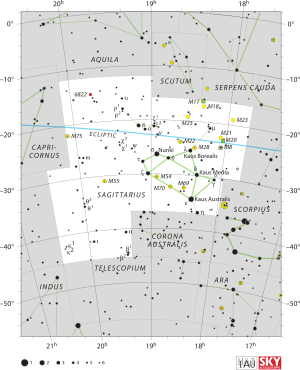HD 177765
| Observation data Epoch J2000.0[1] Equinox J2000.0[1] | |
|---|---|
| Constellation | Sagittarius |
| Right ascension | 19h 07m 09.77940s |
| Declination | −26° 19′ 54.5064″ |
| Apparent magnitude (V) | 9.15[2] |
| Characteristics | |
| Evolutionary stage | A5 SrEuCr[3] |
| B−V color index | 0.45[2] |
| J−H color index | 0.071[4] |
| J−K color index | 0.055[4] |
| Astrometry | |
| Proper motion (μ) | RA: -2.063[1] mas/yr Dec.: −4.425[1] mas/yr |
| Parallax (π) | 2.5411 ± 0.0186 mas[1] |
| Distance | 1,284 ± 9 ly (394 ± 3 pc) |
| Absolute magnitude (MV) | 1.55,[5] 1.166[6] |
| Details[5] | |
| Mass | 1.81, 2.2[7] M☉ |
| Radius | 2.57 R☉ |
| Luminosity | 18.9, 26.9,[6] ~32[7] L☉ |
| Surface gravity (log g) | 3.79 cgs |
| Temperature | 7420, 7002,[6] 8000[7] K |
| Rotational velocity (v sin i) | 2.50[8] km/s |
| Age | 955 Myr |
| Other designations | |
| Database references | |
| SIMBAD | data |
HD 177765 is a white-hued star in the southern constellation of Sagittarius. With an apparent magnitude of 9.15, it is too faint to be seen by the naked eye from Earth, but is dimly visible using binoculars.[9] It is located at a distance of 1,284 light-years (394 parsecs) according to Gaia EDR3 parallax measurements.
Description
[edit]The star is classified as a rapidly oscillating Ap star (roAp star). It shows super-solar abundances of chromium and strontium as well as many rare-earth elements such as europium and cerium, but is depleted of carbon and nickel.[8] In 2012, the star was found to pulsate with a low radial velocity amplitude of 7–150 m/s and a period of 23.6 minutes, the latter being the longest out of any known roAp star at the time.[7] Two additional pulsation frequencies were detected in 2016.[10]
The precise stellar parameters vary from publication to publication, but the star is considered to be part of a group of evolved roAp stars with long pulsation periods, alongside β CrB A and HD 116114. The existence of this group implies a systematic shift of rare-earth emission line anomalies as roAp stars age.[7]
References
[edit]- ^ a b c d Brown, A. G. A.; et al. (Gaia collaboration) (2021). "Gaia Early Data Release 3: Summary of the contents and survey properties". Astronomy & Astrophysics. 649: A1. arXiv:2012.01533. Bibcode:2021A&A...649A...1G. doi:10.1051/0004-6361/202039657. S2CID 227254300. (Erratum: doi:10.1051/0004-6361/202039657e). Gaia EDR3 record for this source at VizieR.
- ^ a b Høg, E.; et al. (February 2000). "The Tycho-2 Catalogue of the 2.5 Million Brightest Stars". Astronomy and Astrophysics. 355 (1): L27–L30. Bibcode:2000A&A...355L..27H.
- ^ Renson, P.; et al. (19 March 2009). "Catalogue of Ap, HgMn and Am stars". Astronomy & Astrophysics. 498 (3). EDP Sciences: 961–966. Bibcode:2009A&A...498..961R. doi:10.1051/0004-6361/200810788. ISSN 0004-6361. Record for this source at VizieR.
- ^ a b c "HD 177765". SIMBAD. Centre de données astronomiques de Strasbourg. Retrieved 30 October 2024.
- ^ a b Glagolevskij, Yu. V. (2019). "On Properties of Main Sequence Magnetic Stars". Astrophysical Bulletin. 74 (1). Pleiades Publishing Ltd: 66–79. Bibcode:2019AstBu..74...66G. doi:10.1134/s1990341319010073. ISSN 1990-3413. Record for this source at VizieR.
- ^ a b c Scholz, R.-D.; Chojnowski, S. Drew; Hubrig, S. (2019). "Strongly magnetic Ap stars in the Gaia DR2 Hertzsprung-Russell diagram". Astronomy & Astrophysics. 628. EDP Sciences: A81. doi:10.1051/0004-6361/201935752. ISSN 0004-6361. Record for this source at VizieR.
- ^ a b c d e Alentiev, D.; et al. (1 March 2012). "Discovery of the longest period rapidly oscillating Ap star HD 177765". Monthly Notices of the Royal Astronomical Society: Letters. 421 (1). Oxford University Press (OUP): L82–L86. arXiv:1112.4473. Bibcode:2012MNRAS.421L..82A. doi:10.1111/j.1745-3933.2011.01211.x. ISSN 1745-3925.
- ^ a b Ghazaryan, S; Alecian, G; Hakobyan, A A (19 June 2019). "Statistical analysis of roAp, He-weak, and He-rich stars". Monthly Notices of the Royal Astronomical Society. 487 (4). Oxford University Press (OUP): 5922–5931. arXiv:1906.06984. doi:10.1093/mnras/stz1678. ISSN 0035-8711. Record for this source at VizieR.
- ^ Zarenski, Ed (2004). "Limiting Magnitude in Binoculars" (PDF). Cloudy Nights. Archived (PDF) from the original on 21 July 2011. Retrieved 6 May 2011.
- ^ Daniel L., Holdsworth (18 October 2016). "Detection of new pulsations in the roAp star HD 177765". Information Bulletin on Variable Stars (6185). Information Bulletin on Variable Stars (IBVS): 1–5. doi:10.22444/ibvs.6185. ISSN 0374-0676.

